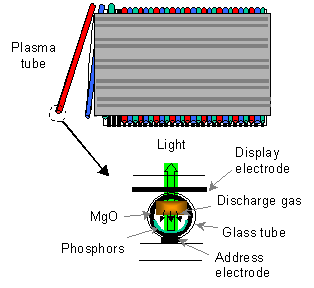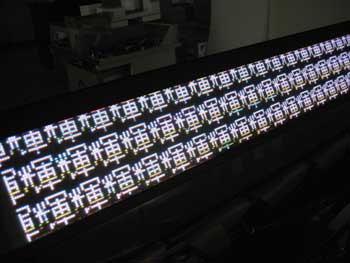 |
|
Fujitsu Laboratories Ltd.
|
Fujitsu's Plasma Tube Technologies Herald Advent of 100-Inch-
Plus Flat-Screen Displays
Kawasaki, November 12, 2003 -- Fujitsu Laboratories Ltd. today announced the development of a revolutionary new plasma tube technology to produce narrow glass tubes, measuring one meter in length and one-millimeter in diameter, that emit light using the same phosphor structure as in a conventional PDP (plasma display panel). In addition, the company has developed a technology that sandwiches an array of these plasma tubes between two electrode plates to make up a display panel. Fujitsu succeeded in producing a prototype panel using 128 plasma tubes (for a screen size of 128 mm x 1 m) that display moving images in color.
Since it is now possible to produce plasma tubes that measure one meter, the company's latest achievement represents a big step toward commercializing plasma array displays.
This technology heralds the advent of large-screen flat-panel displays measuring more than 100 inches diagonally that are lightweight, can be configured into different shapes with a high degree of flexibility, and that can be produced using smaller-scale equipment than required for the production of conventional PDPs of similar size.
The new technologies afford ultra-large displays for indoor use that can curve to the full extent of one's spatial vision, resulting in a vivid sense of immediacy that invites new applications for displays, such as virtual-reality education, virtual stadiums, and other uses of broadband media.
Developed with funding assistance received from NEDO (New Energy and Industrial Technology Development Organization) from fiscal 2000 to 2002, proof of concept of the technology was demonstrated with a prototype display measuring 15 centimeters diagonally in May 2002.
Background
With broadband networking growing more advanced and widespread, very large video displays are expected to be vital adjuncts to the next generation of networking, connecting people together in a visual space that helps them share information directly and participate in a shared environment. Display technologies that enable life-size images of people and objects to be displayed, for example in a display that covers an entire wall of a room, are considered vital in linking people together through virtual shared environments. The advent of extremely large screen displays, therefore, can be considered indispensable to the widespread adoption of next-generation broadband media applications.
Technological Issues
For indoor screen displays measuring more than 100 inches, front projectors have conventionally been used, but this approach has a variety of drawbacks, chief among them the inability to produce a sharp picture except in a dark room. Because of these drawbacks, there was a desire for large-screen displays using an emissive-type display. Another approach, creating an array of light-emitting diodes (LEDs), is already available commercially, but creating a grid of millions of LEDs is difficult to do at a reasonable cost. Such a grid would require large-scale matrix drivers, which consume heavy amounts of electricity, making the power requirements of a 100-inch indoor display exceed 3000 watts.
Plasma display panels, based on emissive principle using discharge, actually have better luminous efficiency at larger sizes, so PDPs have a clear advantage over other types of displays in that the bigger they are, the more power efficient they are (in terms of power consumption per inch of screen size). Still, producing a 100-inch PDP would require glass substrates measuring more than two meters across, entailing large-scale facilities and considerable capital investment.
Fujitsu's New Technologies
The plasma tube-related technologies have the following features:
- Extension of PDP technology
A plasma tube array is a mass of plasma tubes, each measuring one-millimeter in diameter and one meter in length, and each of which contains the same phosphors as a conventional PDP. The tubes are laid out in an array and sandwiched between electrode plates (see Figure 1). The array uses three types of plasma tubes-consisting of red, green, and blue phosphors-and by pulsing voltages to the electrodes, it can generate specific colors. The same driver chips widely used in plasma display panels can also be used for plasma tube arrays. Because the electrode plates are manufactured separately from the plasma tubes, they are considerably simpler to produce.
- Ultra-lightweight, flexible screen size & shape
The fact that no large sheets of glass are required means that plasma tube arrays can weigh as little as one-quarter or less of conventional PDPs. Development is underway to produce a display measuring 3 x 2 meters that will weigh 20 kilograms. And because the displays are simply modular assemblies of plasma tubes, display size can easily be increased simply by expanding the number of tubes used in the array. Development right now is focused on displays ranging from 3 x 2 meters to 6 x 3 meters. The display's shape can also be easily changed by arranging the tubes differently, with domed and cylindrical displays as possibilities.
- High luminous efficiency
With PDP technology, luminous efficiency rises with larger cell sizes (dischargechambers). Since the elements in a plasma tube array are considerably larger than a conventional PDP's cell, they are expected to be more efficient. Fujitsu's goal is to make them four times as efficient as current PDPs, so that at a peak luminosity of 1000 candela per square meter (equivalent to a plasma TV), a 100-inch plasma tube array should consume only a few hundred watts. The current development goal for plasma tube arrays is to ultimately achieve a luminous efficiency of over five lumens per watt.
- Low-cost production
Manufacturing large PDPs requires equipment that can handle enormous glass substrates. With the plasma tube array, by contrast, the basic unit of production is a single, narrow plasma tube, which can be produced with much smaller-scale equipment. Furthermore, whereas conventional PDPs require clean-room conditions to keep contaminants out of the display's interior, plasma tubes have an inherently contaminant-resistant design, making clean rooms unnecessary.
Future Development
The technology is currently being evaluated for luminance lifetime and other reliability factors, and production and assembly techniques are also being developed. Fujitsu expects to complete the reliability assurance process and the development of fabrication and assembly equipment within two years.
- Figure 1:

- Figure 2: Prototype plasma array display

About Fujitsu Laboratories Ltd.
Founded in 1968 as a wholly owned subsidiary of Fujitsu Limited, Fujitsu Laboratories Limited is one of the premier research centers in the world. With a global network of laboratories in Japan, China, the United States and Europe, the organization conducts a wide range of basic and applied research in the areas of Multimedia, Personal Systems, Networks, Peripherals, Advanced Materials and Electronic Devices.
Internet : http://www.labs.fujitsu.com/en/
All company/product names mentioned may be trademarks or registered trademarks of their respective holders and are used for identification purpose only.
Please understand that product prices, specifications and other details are current on the day of issue of the press release, however, may change thereafter without notice.

|
 |



